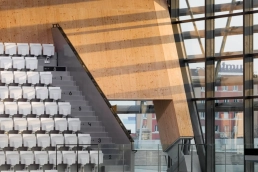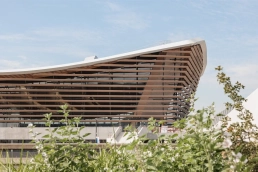The Aquatic Centre Used During the Olympic and Paralympic Games Meets Ecological Needs!
With the 2024 Olympic and Paralympic Games taking place in the French capital, organisers opted for building infrastructures using as many sustainable and renewable materials as possible. One of the best examples is the Olympic pool in Paris.
This new Aquatic Centre is a multifunctional space featuring a 50-metre pool as well as a diving basin. With a capacity of up to 6,000 spectators, this Aquatic Centre hosted water polo, diving, and synchronised swimming competitions during the Olympic Games in July, before being transformed into a boccia stadium for the Paralympic events. After the games, it will serve the local and national swimming community.
Sustainable ecological buildings can be extremely beneficial to the environment. In Europe, reinforced concrete is the primary material used for building constructions, made by mixing steel and enhanced cement. However, concrete production is neither renewable nor sustainable and contributes to 10% of global greenhouse gas emissions. Ecologists and industry experts suggest that wood construction could be a viable solution to this now urgent issue.
Constructing the Aquatics Centre for the Olympic Games
Since the French government recently passed a sustainability law, the Aquatic Centre was built using bio-based materials and solar energy infrastructure. However, during the construction phase, these materials may be more prone to fire hazards. To ensure the safety of the site and its workers, Ramtech’s WES3 wireless system was installed.
Ramtech’s WES3 system, combined with the REACT platform, offers an effective solution to significantly reduce fire risks on timber construction sites. The WES3 system can detect and extinguish small fires before they escalate, greatly reducing the risk of significant damage. Meanwhile, the cloud-based REACT platform alerts project managers to any fire alarm activations on their mobile phones, even when the site is unoccupied.
This real-time 24/7 monitoring allows for rapid responses, targeted interventions, and improved site safety at all times. By integrating WES3 and REACT, construction teams can protect their projects and ensure the safety of their timber structures from the start. The system successfully protected the site throughout daily operations and even when it was unoccupied. The facility was built and used for both major events.


The importance of sustainability
Timber construction can be extremely beneficial, both for the environment and those who end up using these infrastructures. By protecting these buildings during the early phases, citizens and governments can realise the importance and economic efficiency of such constructions.
Transitioning to more sustainable materials and practices can be challenging. However, thanks to new innovative technologies, achieving the UN’s goal (namely, striving for net zero emissions and building resilient and sustainable infrastructures) is no longer a question of “if,” but a matter of “when.” The movement is underway!
Photography Credit: Salem Mostefaoui